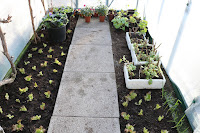THE
NEW GARDENING YEAR HAS STARTED
Now
that 2019 has passed and that very wet year is behind us we now look
forward to 2020 hoping that a warmer and sunnier year is ahead. Yet
again we seem to be having a mild winter, and half way through
January the garden has not seen one snow flake.
I always draw up a rough guide at the end of the last
season of where the next crops are going in the following year so I
can plan a rotation which I need so I can allocate garden compost to
those crops that need the most. The peas, beans, onions, leeks, sweet
corn, courgettes, pumpkins get a good helping, then the potatoes and
brassicas also get some, but the root crops and salads are fine on
land that was composted the previous year.
 |
| Time for a break on a sunny January |
The first snowdrops are in flower and the aconites are not far behind. The wet December put a stop to the winter digging, but there were a few frosty days when it was ok to crack on with the digging, then
 |
| Greenhouse in January |
The
short day length limits time spent outdoors, but we can always find a
few indoor tasks. This is a
 |
| Potato Casa Blanca |
 |
| Angels Trumpet |
In
the past I had always grown some Cape Gooseberries outdoors in a
sheltered spot, but after a few wet, cold and dreich summers when
ripening of the fruit was a problem I gave up on them. However this
year I will try them again as they are a lovely fruit when we get a
decent summer.
 |
| Cape Gooseberry painting |
Another
plant from the past that will get planted is the Brugmansia, also
known as Angels Trumpets as I just love the scent, and they make a
great dot plant in a large tub with other summer bedding plants
around it. This flower is pollinated by night flying moths so the
best scent comes in the evening, so best to use it on patios where
you often relax on a
warm summers evening.
The
greenhouse got tidied up after the tomato plants had finished and old
plants removed and the grapes harvested. Once they had lost their
leaves in December the vines got spur pruned back to the upright
cordons. The borders then all got some compost and a light dressing
of fertiliser and I planted a few plants of lettuce Lollo Rossa and
some spring onions. This will give us some fresh salads over winter,
but as we go into early spring the greenhouse will again be bursting
at the seams as young growing plants fight for space.
Wee jobs to do this
week
The Geraniums taken
from autumn cuttings are now all rooted and beginning to put on
growth. To
create short jointed plants grow them in a cool room with
plenty light and remove any flowers as they appear. Also remove the
tops to hold back growth and encourage a bushy plant.END





















